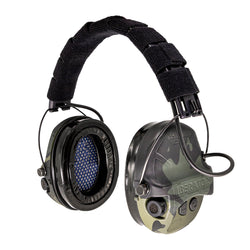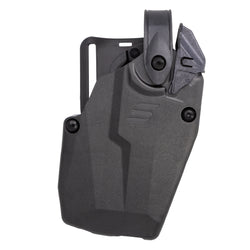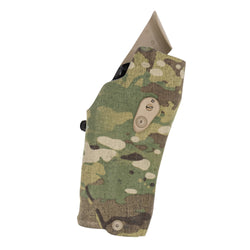As we all know, the John M. Browning-designed 1911 pistol is an American icon. For over 70 years, it served as the standard-issue sidearm for the United States Armed Forces. It was just as revolutionary in design as Glock was in the late 1980’s.
Chambered in .45 ACP, it gave the military the stopping power they needed for American troops, and it was feared by enemy soldiers.
Like any iconic firearm, just about every gun company now makes their own version of the 1911 handgun. Even though it doesn’t have the magazine capacity of newer guns, and it’s much heavier, there is something about the 1911 that just draws people in. It feels natural in your hand, which is part of why Browning’s design is so legendary.

My Grandfather had a 1911, and this was the first semi-auto handgun I remember shooting. Today, I carry a wide range of modern handguns, but I still admire the 1911 handgun and find myself drifting towards them in gun stores. I like to see the different variations from manufacturers around the world. Some of these variations I like, and some I don’t.
A deal you can’t pass up
Every now and then, you find a deal that is just too good to pass up. I’ll admit this doesn’t happen very much with guns, but occasionally you get lucky. I recently found a .45 ACP Llama that fell into this category.
I was at an auction where guns often sell for top dollar and then some. In this case, however, the auctioneer held up an old rusty Llama and started the auction at $300, with no bids. He lowered the price and continued in his lightning-fast auctioneer voice. But there were still no bidders.

He got all the way down to $70 before I couldn’t help myself and placed a bid. One other person bid $80, and I won the auction at $90.
I can’t say I had ever looked at a Llama or wanted one before, but at this price, I couldn’t pass it up. I took the Llama home and started to clean it up the best I could. A lot of the rust came off, but the finish still shows the rough life this gun lived.
The insides were in better shape than the finish, and after a good cleaning, the gun was cycling smoothly and ready for a range visit.
Gabilondo y Cia: The Spanish take of the 1911
The Llama .45 was manufactured by Gabilondo y Cia, a firearms company in Spain. Founded in 1904, the company was initially known as Gabilondo and Urresti. Based in the Basque Country, a region with a history of gunsmithing, they produced a variety of firearms.
The slide of the Llama .45 bears the inscription “GABILONDO Y CIA – VITORIA (España),” indicating its place of origin. During its time, Gabilondo y Cia was a significant player in the European and Latin American firearms markets.
In the latter half of the 20th century, the Llama .45 found its way to the United States. It was imported by Stoeger Industries, a well-known name that imports all types of firearms. The partnership between Gabilondo y Cia and Stoeger introduced a more affordable, 1911-style handgun to the American market. This made the Llama .45 an accessible option for those who admired the 1911 platform but sought a more budget-friendly alternative.

In 1992, the company filed for bankruptcy and was purchased by a group of employees who changed the name to Fabrinor Arma Corta y Microfusion, S.A. They continued to use the Llama name until the company again went under. By 2005, the company closed its doors for good.
A Familiar Form with a Different Feel
At first glance, the Llama .45 is unmistakably a 1911 derivative. It has the same general profile and operating principles as Browning’s 1911. Some of these features include the trigger system, grip safety, thumb safety, etc. It also uses standard 1911 magazines.
Even though a lot of this gun appears to be basic 1911 DNA, the grips are completely different. This was a big disappointment for me because the grips are one of the things I dislike the most.
They are thick, making the gun feel more like a double stack pistol, and they feel like cheap plastic. The frame itself appears to be the same thickness as my other 1911’s so I’m not sure why they chose to use a proprietary grip.
There are some deep seriations on the back of the slide, but none on the front. This makes it a little hard to rack the slide for me as I like to grip the front of the slide with 1911’s.

Another disappointment for me was the slide release, which is extremely hard to push. I cleaned it several times to make sure it wasn’t rust or dirt getting in the way, but that isn’t the case. It’s possible the spring has too much tension, but I haven’t tried replacing that yet.
Field stripping the Llama was standard for a 1911. But again, the recoil spring was much harder to compress than my other 1911 pistols. It took me a minute to get the slide back on after cleaning it.
Because the grips are thicker, holding the Llama did feel different from my other 1911 pistols, but it did retain that “natural” angle that makes 1911 pistols stand out. I can’t say it was uncomfortable, but it felt a little more like a double stack handgun.
Besides the grips, the other parts on the Llama are standard 1911. If you find yourself wanting to try one out, it’s important to note that some parts may require fitting. Even though later models (80’s and beyond) used 1911 standard parts, they do not drop right in. This isn’t uncommon for 1911 handguns, as many require a little work to make them fit correctly.
On the range with the Llama .45
When you buy a pistol this cheap, the real test isn’t how it looks, but how it shoots. This is where I was completely surprised and impressed. The Llama was made to be a budget-priced 1911-style gun more than a decade ago. To be honest, I wasn’t planning on it even functioning correctly, thinking I would just use it as a wall decoration.
My first magazine was extremely smooth, and the slide locked open on the last round. I loaded it up again and continued to fire. I’m guessing the smooth feeling is a combination of the weight and strong recoil spring, but it didn’t kick as much as I expected it to.

Someone had added some paint to the front blade sight as well as the rear dovetail sight. Even though the sights looked rough, the gun was pretty accurate. The trigger had about 1/8-inch slack, but the hammer release was great. My Wheeler trigger gauge showed an average trigger pull of 3.8 pounds, which is on the light end.
I did finally get the Llama to jam when I put some hollow point ammo in it, but this wasn’t surprising for a 1911. It cycled through every type of ball ammo I tried, however, without any malfunctions. AmmoToGo.com supplied several hundred rounds of Federal 45 Auto 230 grain ammo for the review, so a big thank you to them!
Not a hidden gem, but a great find
This gun isn’t what I would call a “hidden gem” because, after all, it’s a budget gun from the late 80’s. But it’s still exciting to find such a good deal on an old gun. The process of cleaning it up (the best I could anyway) and having some fun at the range is worth the $90 price tag.
The Llama fits great in my Safariland 578-GLS, so I have been using it for training. I don’t have to worry about scratching it up, and it works with all my 1911 magazines.
For me, this was a fun project and a great find. It’s not a pretty gun, but it is still part of the legendary 1911 history.









